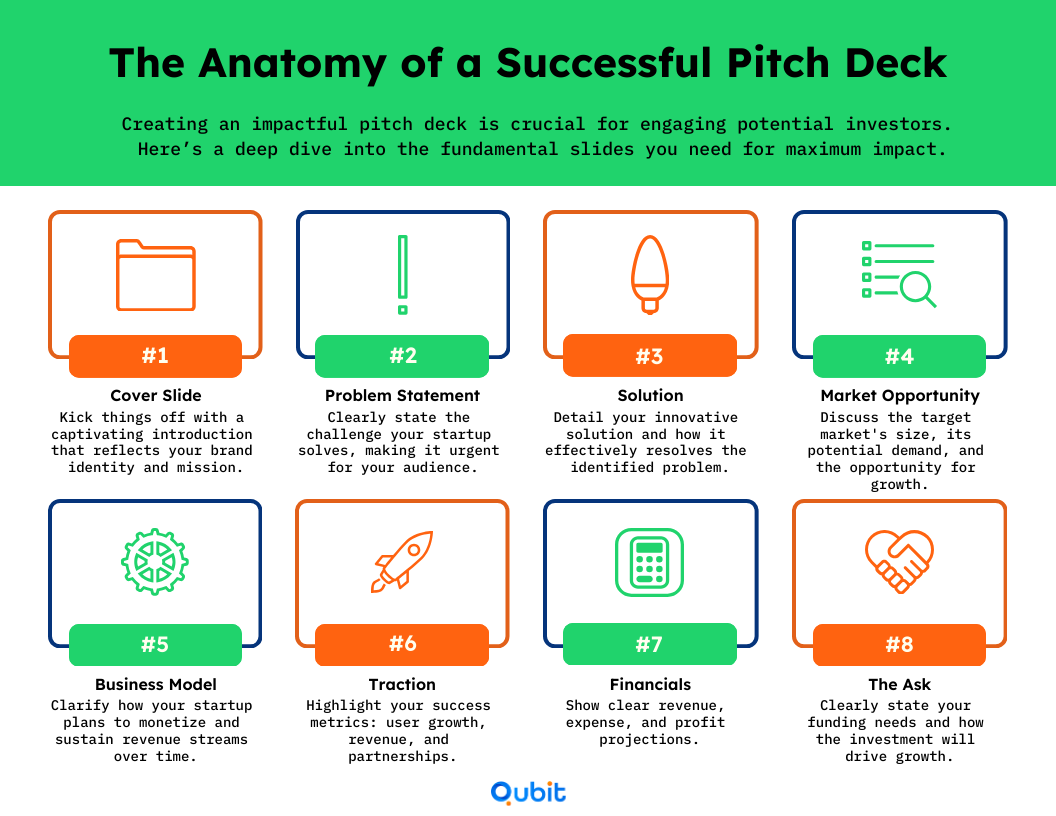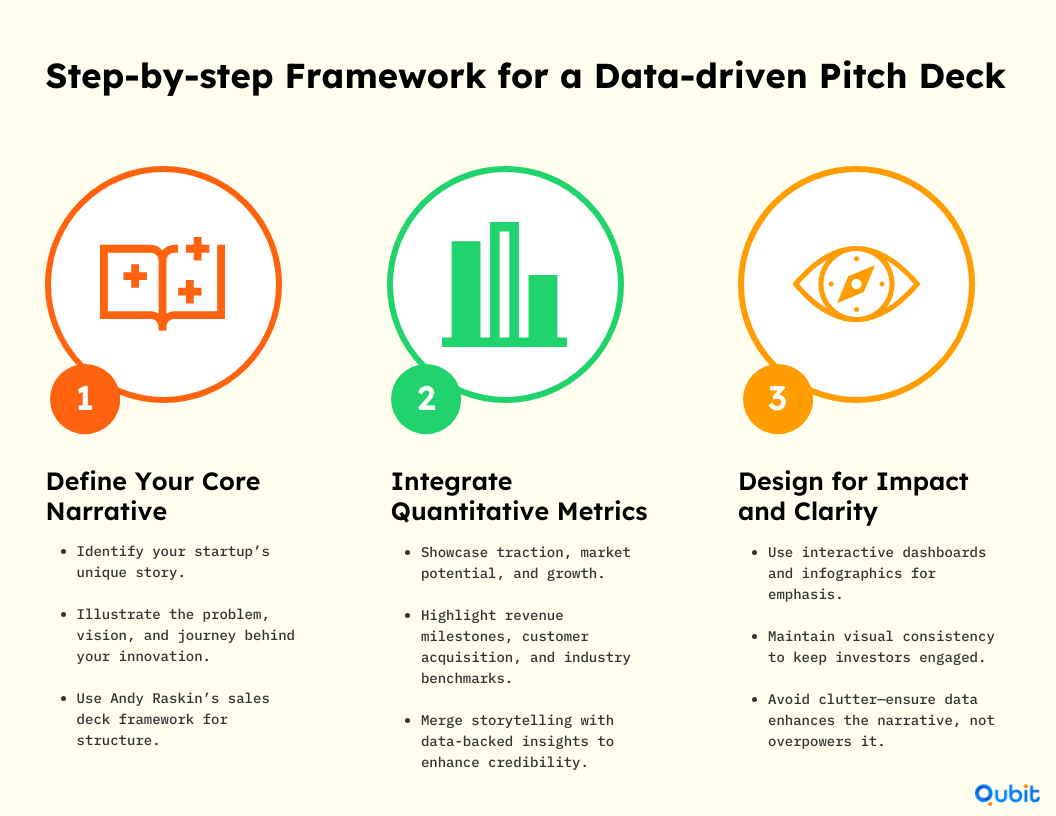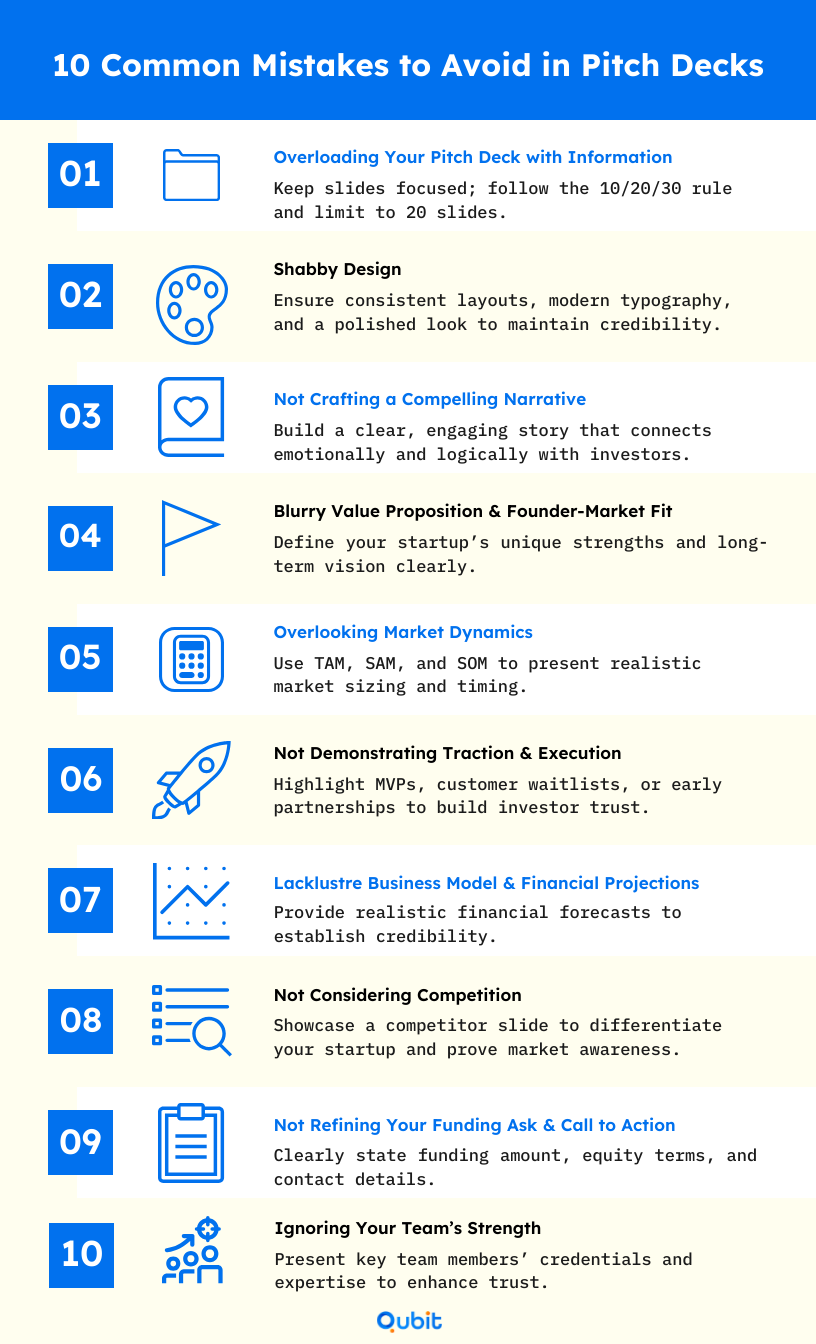The pitching deck has evolved far beyond a simple slideshow; it’s now a dynamic tool where narrative techniques, interactive design, and data-driven insights converge to tell a compelling story.
Whether you’re new to creating a pitch deck or looking to refine your approach, understanding the foundational components of a pitch deck is essential. For beginners, grasping the essential pitch deck elements ensures your deck is ready to make an impact before advancing to more specialized strategies.
This article dives into practical steps for crafting a pitch deck for investors that stands out in a saturated market. Let’s explore how storytelling and design can elevate your deck to secure the attention—and capital—you need.
Understanding the Pitching Deck Landscape

Market Stats
The pitching deck landscape is both dynamic and competitive, with over 1,000 new pitch decks created daily. Yet, only 1% of these decks manage to secure funding, highlighting the immense challenge startups face in standing out. This sheer volume underscores the need for precision, creativity, and a clear narrative in your presentation. According to pitch deck stats, investors expect concise, data-driven storytelling that efficiently communicates your vision, market opportunity, and growth potential.
Market saturation is evident, making it crucial to analyze these statistics to better understand the competitive environment. For founders, this means prioritizing structure and clarity while avoiding information overload. The ideal pitch deck reportedly contains 10–15 slides, focusing on key aspects such as the problem, solution, traction, and financial projections. These metrics serve as a guiding framework, ensuring your deck aligns with investor expectations and maximizes its impact.
Investor Review Times
Investor behavior adds another layer of complexity to the pitching deck process. On average, venture capitalists spend just 3 minutes and 44 seconds reviewing a pitch deck. This brief window of attention demands a razor-sharp focus on crafting compelling visuals and concise content.
A strong introduction, such as a striking cover slide or an engaging executive summary, can determine whether the investor continues reading or moves on. Similarly, slides detailing your traction—whether it’s user growth, revenue milestones, or partnerships—are often prioritized during this limited review time. Founders must ensure the deck flows logically and avoids redundant or overly complex information.
Understanding these review metrics is invaluable for contextualizing the competitive landscape. By adopting a clear structure and leveraging the pitch deck definition you can tailor your deck for maximum engagement within the short review period.
Advanced Narrative Techniques for Investor Engagement
Crafting a compelling pitch deck requires more than just sleek visuals; it demands a story that resonates deeply with investors. When done effectively, storytelling transforms your pitching deck into a powerful tool for persuasion, with data showing that presentations with a clear message are up to 43% more persuasive than those overloaded with information. Let’s explore advanced techniques to refine narrative clarity and enhance investor engagement.
Key Narrative Strategies
One of the most effective frameworks to structure your pitch deck story is the Hero’s Journey, a narrative arc that mirrors the challenges and triumphs of your startup. By positioning your company as the “hero,” you can showcase obstacles faced, innovative solutions developed, and the ultimate impact on your target market. This approach builds emotional engagement and highlights your startup’s growth potential.
Incorporating authentic anecdotes, such as the inspiration behind founding your company or a pivotal turning point, also adds relatability to your pitch deck structure. Pair these stories with market data and customer testimonials to reinforce credibility. According to research, blending emotional storytelling with factual evidence can significantly boost investor confidence, making your narrative not only compelling but trustworthy.
No-design Draft Focus
Before jumping into design, start with a no-design draft to perfect the flow of your story. By focusing solely on the narrative, you can refine each slide without the distraction of visuals. This initial draft helps ensure that every concept in your pitch deck is clear, concise, and impactful.
Here’s how to make it work: outline your story slide by slide, prioritizing clarity in your messaging. For example, your “Problem” slide should succinctly describe the market gap, while the “Solution” slide should articulate how your product addresses it. This process allows you to identify and rectify weak points in your narrative before transitioning into design.
Iterative Messaging Refinement
Even a well-crafted story needs refinement. Iterative messaging involves revisiting your pitch deck frequently to incorporate new market insights, data trends, or investor feedback. For instance, if investors seem skeptical about your market opportunity, integrating updated statistics or projections can address their concerns. This method ensures your narrative stays dynamic and responsive to the latest developments.
Additionally, leveraging feedback loops with mentors or industry experts can help sharpen your pitch deck structure further. The experience will also teach you how to emotionally engage with investors. Incorporating their perspectives can highlight overlooked strengths and mitigate weaknesses, ensuring your messaging remains laser-focused.
By blending emotional narratives with data-driven insights, a “pitching deck” can evolve into a powerful tool for engagement.
Iterative Design and Minimalist Trends
Creating a pitch deck requires more than just presenting information—it’s about crafting a visual story that resonates with investors. Two powerful design methodologies, iterative feedback, and minimalism, can simplify this process while enhancing clarity. By integrating professional design tools, startups can refine their approach step-by-step and deliver impactful presentations.
Iterative Feedback Loops
Start with a no-design draft to focus on content without distraction. This initial version should prioritize structure and narrative flow, laying the groundwork for visual elements later. Once your draft is ready, share it with trusted colleagues or mentors to gather feedback. Their insights can help you identify areas for improvement, ensuring your pitch aligns with investor priorities.
The feedback loop process is invaluable for creating a pitch deck that evolves with each iteration. By refining visuals, text, and layout based on constructive input, startups can avoid common pitfalls like cluttered pages or unclear messaging. This iterative approach ensures that every detail serves a purpose, making your deck polished and investor-ready.
Using Professional Design Tools
Design tools streamline the process of transforming feedback into actionable improvements. For example, you can use design tools to quickly access professional templates, saving time while maintaining high aesthetic standards. Canva, for instance, offers customizable templates that align with minimalist trends while ensuring your deck looks polished.
Figma allows multiple users to edit and review the deck in real-time, fostering teamwork and creativity. With these tools, you can focus on creating a pitch deck that balances functionality and style.
Embracing Minimalism
Minimalism is more than an aesthetic choice—it’s a strategic approach to avoid overwhelming investors. By emphasizing clean layouts, concise text, and purposeful visuals, you can create a deck that highlights key points without excessive detail. This clarity helps investors grasp your message quickly and keeps their focus on what matters most.
Adopting a minimalist design also means eliminating unnecessary distractions, such as overly elaborate graphics or excessive jargon. Instead, use visuals strategically—charts, infographics, or images—to reinforce your narrative. A well-designed pitch deck should guide investors seamlessly through your story, leaving a lasting impression.
By combining iterative feedback loops, professional design tools, and minimalist trends, startups can craft a pitching deck that stands out.
Adding Data and Statistical Insights in Your Deck
When crafting a successful pitching deck, integrating data and statistical insights can significantly enhance its impact. Investors often prioritize numbers—they want evidence that substantiates your claims and showcases your startup’s growth potential.
Incorporating Key Statistics
The components of a pitch deck that resonate most with investors include clear, data-driven sections. This means showcasing metrics such as revenue growth, customer acquisition rates, or market share in a visually compelling manner. For example, research indicates that decks with concise messaging and relevant statistics improve persuasiveness
To leverage this, align your statistics with your narrative. If your startup operates in a competitive market, benchmark your figures against industry standards. Demonstrating your ability to outperform competitors strengthens your credibility.
Quantitative Storytelling
Numbers alone won’t captivate; they need context. Quantitative storytelling combines metrics with a compelling narrative to weave a stronger case around your achievements. For instance:
- Highlight how your customer base grew by XX over six months due to a targeted marketing strategy.
- Pair this with a graph showing month-over-month growth to illustrate the upward trajectory visually.
The goal is to use data not as standalone figures but as part of a narrative that reflects your vision and scalability. Consider explaining how these achievements pave the way for future milestones, adding layers of relevance to your story.
Measuring Impact
Integrating visual charts and graphs into your pitching deck makes data digestible. Investors are more likely to trust a deck that employs visual aids to present complex information. Pie charts, bar graphs, and infographics simplify data representation, ensuring clarity.
Additionally, when discussing impact, focus on outcomes. Highlight how your strategies have translated into tangible results—such as improved profitability or market penetration. This approach not only supports your claims but also demonstrates your ability to execute successfully.
Incorporating precise statistics and benchmarking against industry standards ensures your deck stands out. By blending data with storytelling and visuals, your pitch becomes both persuasive and memorable.
Pitching Decck Case Studies
Understanding how successful startups crafted their pitch decks can provide invaluable lessons for anyone creating a pitch deck. By diving into real-world examples like LinkedIn’s Series B pitch deck and Labonachip, LLC’s design strategies, we’ll explore effective storytelling and structural approaches that resonate with investors.
LinkedIn Series B Insights
LinkedIn’s Series B pitch deck is a standout example of how precise narrative and robust data can secure investor confidence. At its core, the deck emphasized user growth, multiple revenue streams, and an ambitious yet achievable vision for scaling. It wasn’t just about showcasing numbers; LinkedIn used a structured flow to tell a compelling story of progression and opportunity.
The slide structure included clear segmentation: starting with market opportunity, followed by traction metrics, and concluding with future projections. By presenting data in digestible formats—like graphs and concise bullet points—LinkedIn ensured investors could easily grasp its growth trajectory. Moreover, its narrative tied each section back to the overarching vision, making it cohesive and impactful.
For those working on a pitch deck for investors, LinkedIn’s approach serves as a blueprint. Focusing on clarity and connecting metrics to a broader story helps investors envision the potential return on their investment. To learn more, LinkedIn’s Series B pitch deck offers a case study worth exploring for actionable insights.
Labonachip, LLC Example
Labonachip, LLC took a unique approach to crafting its pitch deck by emphasizing its groundbreaking innovation—a pioneering in-vitro diagnostic platform. Unlike LinkedIn’s data-heavy deck, Labonachip infused its presentation with a balanced mix of technical detail and human-centered narratives. This allowed investors to connect not only with the product’s capabilities but also its broader impact on healthcare advancement.
One standout feature of Labonachip’s pitch example was its ability to simplify complex concepts. The deck used visuals and analogies to demystify its technology, ensuring that even non-technical investors could grasp its value proposition. It also highlighted funding outcomes, showing how its strategic deck earned confidence and capital for development.
When creating a pitch deck, Labonachip’s example underscores the importance of adapting content to fit the audience. Technical startups can benefit from breaking down complexities and tying their innovation to societal benefits. Start by reviewing this pitch example for inspiration on balancing depth with simplicity.
Actionable Insights
Both LinkedIn and Labonachip offer lessons applicable across industries:
- Study the slide structure and narrative flow of successful decks: LinkedIn’s segmented story and Labonachip’s simplified technical explanation are great starting points.
- Compare funding outcomes with deck strategies: Evaluate how strong storytelling and tailored content drive investor decisions.
- Extract actionable lessons from each case study: Whether it’s clarity, innovation, or audience alignment, these examples provide practical strategies to refine your approach.
By applying these insights, you can elevate your pitch deck into a compelling narrative that aligns with investor expectations.
Emotional and Interactive Engagement Strategies
Creating a compelling pitching deck isn’t just about presenting numbers—it’s about connecting on a deeper level. By blending emotional storytelling with interactive multimedia elements, you can captivate investors and foster meaningful engagement. Let’s explore strategies that bring your pitch deck for investors to life.
Infusing Emotion in Your Pitch
Emotional appeal is one of the most effective ways to resonate with your audience. Investors don’t just want to see a business plan—they want to feel your passion. Share a story that illustrates your startup’s journey, highlighting challenges overcome or impactful milestones. For example, if your product has positively impacted customers, show brief anecdotes or visuals that capture their experiences.
When showcasing data, pair it with narratives. Instead of presenting raw statistics, explain how they reflect your story. For instance, “Our 110% growth last year represents the trust our customers place in us.” This approach ties your accomplishments to a human element, making them more memorable.
Interactive CTAs and Multimedia Elements
Interactive pitch decks elevate viewer engagement. Incorporate concise calls-to-action (CTAs) on slides to prompt investors toward specific actions, such as scheduling a follow-up meeting or visiting your website for detailed insights. These CTAs should be direct yet subtle, ensuring they don’t detract from your core message.
Multimedia elements also play a vital role in breaking up text-heavy slides. Use visuals like infographics, charts, or brief video clips to highlight key points dynamically. For instance, a short product demo video can illustrate your solution’s value better than lengthy text. Multimedia engages multiple senses, helping investors retain information more effectively.
Using Expert Testimonials
Credibility is crucial in building trust with investors. One way to achieve this is by including expert quotes or customer testimonials in your pitching deck. Highlight endorsements from industry leaders or satisfied clients who can validate your product’s effectiveness or market potential.
For instance, a slide featuring a concise customer testimonial, accompanied by their photo or company logo, can add authenticity, showcasing social proof in your pitch deck. Similarly, expert quotes from field specialists can demonstrate that your solution aligns with industry standards, further solidifying your credibility.
Crafting the perfect investor pitch deck involves numerous nuances. Qubit Capital offers comprehensive startup fundraising services to guide you through your entire fundraising journey.
By weaving emotion, interactivity, and credibility into your pitch deck for investors, you can transform it into an experience that resonates and drives action.
Tailoring Your Deck to Diverse Investor Profiles
Creating a pitch deck that resonates with a broad range of investors is no small task. Each investor type—be it venture capitalists, angel investors, or corporate funds—has distinct priorities and expectations. By customizing your pitch deck for investors, you can deliver a focused and compelling presentation that addresses their unique needs and enhances your chances of securing funding. This section explores how to assess investor needs, segment your audience, and personalize your content for maximum impact.
Assessing Investor Needs
The first step in tailoring your deck is understanding your audience. Investors come with varying preferences and areas of focus, whether that’s market scalability, product innovation, or financial performance. Conduct thorough research to identify what matters most to them. For example:
- Venture Capitalists often prioritize high growth potential and industry disruption.
- Angel Investors may focus more on your team’s passion and entrepreneurial vision.
- Corporate Investors typically look at strategic alignment with their existing business models.
Understanding these nuances allows you to address specific concerns and highlight the aspects of your business that align with their priorities.
Segmenting Your Audience
Effective segmentation is key when creating a pitch deck that speaks directly to diverse investor profiles. Start by categorizing investors based on their focus areas, such as technology, healthcare, or consumer goods. You can also segment them by investment stage—early-stage investors versus those focused on scaling established businesses.
Once segmented, adjust the tone and structure of your deck to match their expectations. For instance, an early-stage investor might appreciate detailed slides on product development and market entry strategies, while later-stage investors may value robust financial projections and scalability metrics. Tailoring your deck ensures that your advanced strategies are effectively communicated to diverse investor profiles.
Customizing Content
Personalized messaging is what transforms a generic presentation into a powerful pitch. Customize your slide content to address the specific needs, questions, and objectives of each investor segment. For example:
- Highlight market research and competitive analysis for data-driven investors.
- Emphasize the problem-solving capabilities of your product for socially conscious investors.
- Incorporate targeted calls to action (CTAs) that encourage further engagement, such as scheduling follow-up meetings or requesting feedback.
By customizing your pitch deck for different investors, you demonstrate both professionalism and a keen understanding of their specific priorities and investment focus.
Customizing your pitch deck is not just about aesthetics—it’s about building a narrative that resonates deeply with your audience.
Integrating Interactive Multimedia Elements
Transforming your pitching deck into an engaging experience starts with integrating interactive multimedia elements. By incorporating visuals, animations, and embedded media, you can captivate your audience while maintaining a professional pitch deck structure. This section explores actionable techniques to elevate your presentation through multimedia.
Visual Storytelling Techniques
A visually compelling pitch deck is a surefire way to grab attention. Start by selecting high-quality images and graphic assets that complement your narrative. Platforms like this Creative Market offer a variety of design templates and elements to enhance your slides. These resources enable you to create a cohesive visual story that aligns with your brand and message.
Additionally, consider using charts, infographics, and custom illustrations to simplify complex data. Visual storytelling in a pitch deck bridges the gap between dense information and audience engagement, ensuring your deck remains memorable.
Embedding Multimedia
Embedding multimedia elements like videos and animations can transform static slides into dynamic tools for persuasion. Use short, impactful videos to highlight your product’s functionality or showcase customer testimonials. Animations can illustrate processes or transitions effectively, but should be used sparingly to avoid overwhelming your audience.
Interactive elements, such as clickable slides or embedded links, also enhance user engagement. They allow viewers to explore additional content at their own pace, creating a personalized experience.
Best Practices for Tech Integration
When integrating technology into your pitch deck, prioritize mobile responsiveness. Most investors review decks on mobile devices, so ensure your multimedia elements adapt seamlessly across platforms. Additionally, keep animations and videos lightweight to avoid lag or technical issues during presentations.
Consistency is key—maintain uniformity in your design and multimedia usage throughout the deck. This ensures your narrative flows naturally and prevents distractions. Lastly, test all interactive features before presenting to guarantee smooth functionality.
Interactive multimedia, when executed thoughtfully, can elevate your pitching deck and leave a lasting impression. Focus on strategic integration, high-quality assets, and mobile optimization to create a deck that resonates with your audience.
Optimizing Your Pitch Deck: Best Practices and Expert Advice
Creating a compelling pitching deck is about more than showcasing numbers; it’s crafting a story that resonates with investors. From concise slides to showcasing your team’s expertise, every detail matters when perfecting a pitch deck for investors.
Expert Tips
- Keep Your Deck Short: Aim for 10-15 slides. Investors appreciate brevity and focus, so avoid overloading your deck with excessive details. Each slide should deliver a clear message without overwhelming your audience.
- Highlight Key Financial Projections: Your financial models must demonstrate growth potential while remaining realistic. Investors often look for projections that balance ambition with feasibility.
- Showcase Team Expertise: Investors often prioritize the people behind the business. Highlight your team’s qualifications and experience to build credibility and trust.
Refining Your Story
Your pitch deck isn’t just about presenting data; it’s about telling a story investors can connect with. Start by identifying your unique value proposition and weaving it through your narrative. Ensure that every slide builds upon the previous one, creating a cohesive and persuasive flow.
Additionally, rehearse your pitch extensively, aligning your verbal delivery with the story told through your pitching deck.
Final Checks
Before presenting your deck, conduct a thorough review:
- Ensure visuals are clean and professional, enhancing readability.
- Double-check all data for accuracy, as errors can undermine credibility.
- Seek feedback from mentors or industry experts to refine your approach further.
By implementing these best practices, your pitch deck can become a powerful tool for securing funding, leaving investors with a lasting impression.
Conclusion
As you navigate the complexities of startup funding, a precise and compelling pitch deck remains your cornerstone. Throughout this blog, we’ve explored advanced strategies that refine every aspect of your presentation—whether it’s crafting a narrative that resonates with investors or leveraging data to bolster your value proposition. These techniques ensure your pitch isn’t just seen but remembered.
A clear, narrative-driven, and data-backed pitch deck doesn’t merely inform; it inspires confidence and sparks action. It bridges the gap between an idea and its potential, elevating your startup’s positioning in the competitive funding landscape. The importance of this cannot be overstated—investors connect with stories backed by substance, and a well-executed deck delivers both.
If you’re ready to transform your pitch and captivate investors, our Pitch Deck Creation service is designed to help you bridge the gap between strategy and success. Contact us today.
Key Takeaways
- Start with a no-design draft to solidify your narrative.
- Utilize data and quantitative insights to enhance persuasiveness.
- Leverage iterative design tools and minimalist design trends for clarity.
- Customize your pitch deck for diverse investor profiles.
- Incorporate expert advice and real-world case studies to fine-tune your presentation.








